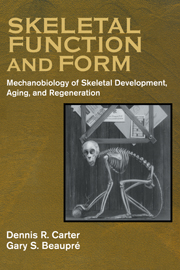Book contents
- Frontmatter
- Contents
- Preface
- Chapter 1 Form and Function
- Chapter 2 Skeletal Tissue Histomorphology and Mechanics
- Chapter 3 Cartilage Differentiation and Growth
- Chapter 4 Perichondral and Periosteal Ossification
- Chapter 5 Endochondral Growth and Ossification
- Chapter 6 Cancellous Bone
- Chapter 7 Skeletal Tissue Regeneration
- Chapter 8 Articular Cartilage Development and Destruction
- Chapter 9 Mechanobiology in Skeletal Evolution
- Chapter 10 The Physical Nature of Living Things
- Appendix A Material Characteristics
- Appendix B Structural Characteristics
- Appendix C Failure Characteristics
- Index
Appendix A - Material Characteristics
Published online by Cambridge University Press: 11 January 2010
- Frontmatter
- Contents
- Preface
- Chapter 1 Form and Function
- Chapter 2 Skeletal Tissue Histomorphology and Mechanics
- Chapter 3 Cartilage Differentiation and Growth
- Chapter 4 Perichondral and Periosteal Ossification
- Chapter 5 Endochondral Growth and Ossification
- Chapter 6 Cancellous Bone
- Chapter 7 Skeletal Tissue Regeneration
- Chapter 8 Articular Cartilage Development and Destruction
- Chapter 9 Mechanobiology in Skeletal Evolution
- Chapter 10 The Physical Nature of Living Things
- Appendix A Material Characteristics
- Appendix B Structural Characteristics
- Appendix C Failure Characteristics
- Index
Summary
Stress
When forces are applied to a structure such as a femur, it will deform slightly from its original geometry, and interatomic distances will be changed throughout the bone. These changes in interatomic distances are associated with very complicated, spatially dependent distributions of local internal forces and deformations. Using continuum models of the femur articular cartilage, cancellous bone, and compact bone, we can conceptually define the intensity of internal forces and the magnitude of internal deformations by the stress and strain values at specified locations. The stresses (dimensions = force per unit area, MN/m2 or MPa) can be mathematically related to the strains (dimensions = length per length, mm/mm). The quantitative parameters used to define the relationships between stress and strain are the material properties of the tissue. Examples of material properties are the tissue elastic modulus and Poisson's ratio, which will be discussed later.
To fully define the state of stress at a point in a structure, one must specify the six independent values of the stress tensor. These six values are the normal stresses and shear stress on three independent planes passing through that point. The concept of stress and strain is simplified, however, when we restrict ourselves to the stress components that act on one specific plane through the point. Consider a femur that is exposed to a particular set of forces acting at a specific time (Figure A.1). The stresses act on a transverse plane at a point within the cortex of the mid-diaphysis. Using the coordinate system shown in Figure A.1, we can define the plane under consideration by z = constant.
- Type
- Chapter
- Information
- Skeletal Function and FormMechanobiology of Skeletal Development, Aging, and Regeneration, pp. 267 - 282Publisher: Cambridge University PressPrint publication year: 2000



